Banyan
A banyan, also spelled "banian",[1] is a fig that begins its life as an epiphyte,[2] i.e. a plant that grows on another plant, when its seed germinates in a crack or crevice of a host tree or edifice. "Banyan" often specifically denominates Ficus benghalensis (the "Indian banyan"), which is the national tree of India,[3] though the name has also been generalized to denominate all figs that share a common life cycle and used systematically in taxonomy to denominate the subgenus Urostigma.[4]
| Banyan | |
|---|---|
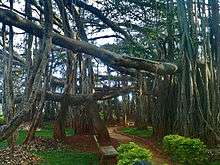 | |
| Banyan with characteristic adventitious prop roots | |
| Scientific classification | |
| Kingdom: | Plantae |
| Clade: | Tracheophytes |
| Clade: | Angiosperms |
| Clade: | Eudicots |
| Clade: | Rosids |
| Order: | Rosales |
| Family: | Moraceae |
| Genus: | Ficus |
| Subgenus: | Ficus subg. Urostigma |
| Species | |
|
Species include: | |
Characteristics
Like other fig species, banyans bear their fruit in the form of a structure called a "syconium". The syconium of Ficus species supply shelter and food for fig wasps and the trees depend on the fig wasps for pollination.
Frugivore birds disperse the seeds of banyans. The seeds are small, and because most banyans grow in woodlands, a seedling that germinates on the ground is unlikely to survive. However, many seeds fall on the branches and stems of other trees or on human edifices, and when they germinate they grow roots down toward the ground and consequently may envelop part of the host tree or edifice. For this reason banyans bear the colloquial name "strangler fig". A number of tropical banyan species that compete for sunlight, especially of the genus Ficus, exhibit this strangling habit.[5][6][7]
The leaves of the banyan tree are large, leathery, glossy, green, and elliptical. Like most figs, the leaf bud is covered by two large scales. As the leaf develops the scales abscise. Young leaves have an attractive reddish tinge.[8]
Older banyan trees are characterized by aerial prop roots that mature into thick, woody trunks, which can become indistinguishable from the primary trunk with age. Old trees can spread laterally by using these prop roots to grow over a wide area. In some species, the prop roots develop over a considerable area that resembles a grove of trees, with every trunk connected directly or indirectly to the primary trunk. The topology of this massive root system inspired the name of the hierarchical computer network operating system "Banyan VINES".
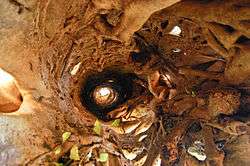
In a banyan that envelops its host tree, the mesh of roots growing around the latter eventually applies considerable pressure to and commonly kills it. Such an enveloped, dead tree eventually decomposes, so that the banyan becomes a "columnar tree" with a hollow, central core. In jungles, such hollows are very desirable shelters to many animals.
Etymology
The name was originally given to F. benghalensis and comes from India, where early travellers observed that the shade of the tree was frequented by Banyans (a corruption of Baniyas, a community of Indian traders).[9]
Classification
The original banyan, F. benghalensis, can grow into a giant tree covering several hectares. Over time, the name became generalized to all strangler figs of the Urostigma subgenus. The many banyan species include:
- Ficus microcarpa, which is native to Sri Lanka, China, India, Nepal, Bhutan, Taiwan, the Malay Archipelago, New Guinea, Australia, Ryukyu Islands and New Caledonia, is a significant invasive species elsewhere.
- The Central American banyan (Ficus pertusa) is native to Central America and northern South America, from southern Mexico south to Paraguay.
- The shortleaf fig (Ficus citrifolia) is native to southern Florida, the Caribbean Islands, Central America, and South America south to Paraguay. One theory is that the Portuguese name for F. citrofolia, os barbados, gave Barbados its name.
- The Florida strangler fig (Ficus aurea) is also native to southern Florida and the Caribbean Islands, and distinguished from the above by its coarser leaf venation.
- The Moreton Bay fig (Ficus macrophylla) and Port Jackson fig (Ficus rubiginosa) are other related species.
In horticulture
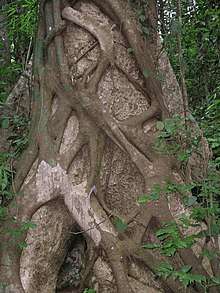
Due to the complex structure of the roots and extensive branching, the banyan is used as a subject specimen in penjing and bonsai. The oldest living bonsai in Taiwan is a 240-year-old banyan tree housed in Tainan.[10]
In culture
Religion and mythology
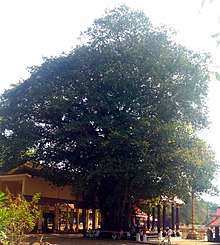
Banyan trees figure prominently in several Asian and Pacific religions and myths, including:
- In the Bhagavat Gita, Krishna said, "There is a banyan tree which has its roots upward and its branches down, and the Vedic hymns are its leaves. One who knows this tree is the knower of the Vedas." (Bg 15.1) Here the material world is described as a tree whose roots are upwards and branches are below. We have experience of a tree whose roots are upward: if one stands on the bank of a river or any reservoir of water, he can see that the trees reflected in the water are upside down. The branches go downward and the roots upward. Similarly, this material world is a reflection of the spiritual world. The material world is but a shadow of reality. In the shadow there is no reality or substantiality, but from the shadow we can understand that there is substance and reality.
- In Buddhism's Pali canon, the banyan (Pali: nigrodha)[11] is referenced numerous times.[12] Typical metaphors allude to the banyan's epiphytic nature, likening the banyan's supplanting of a host tree as comparable to the way sensual desire (kāma) overcomes humans.[13]
- In Guam, the Chamorro people believe in tales of taotaomona, duendes, and other spirits. Taotaomona are spirits of the ancient Chamorro that act as guardians to banyan trees.[14]
Notable specimens
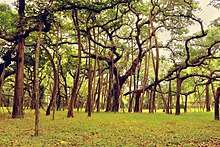
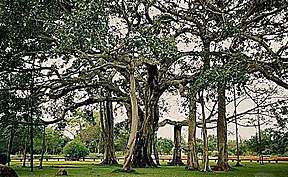
- Thimmamma Marrimanu is a banyan tree in Anantapur, located circa 35 km from the town of Kadiri in the state of Andhra Pradesh, India. It is present in the Indian Botanical Gardens and is more than 550 years old.[15]
- One of the largest trees, the Great Banyan is found in Kolkata, India. It is said to be more than 250 years old.
- Another such tree, Dodda Aalada Mara as in "Big Banyan Tree", is found in the outskirts of Bangalore, India; it has a spread of circa 2.5 acres.[16]
- The Iolani Palace banyans in Honolulu, Hawaii. In the 1880s Queen Kapiolani planted two banyan trees within the Iolani Palace grounds. These trees have since grown into large groupings of trees on the old historic palace grounds.[17]
- Maui, Hawaii has a banyan tree planted by William Owen Smith in 1873 in Lahaina's Courthouse Square. It has grown to cover two-thirds of an acre.[16]
- One large banyan tree, Kalpabata, is inside the premises of Jagannath Temple in Puri. It is considered sacred by the devotees and is supposed to be more than 500 years old.[18]
- A large banyan tree lives in Cypress Gardens, at the Legoland theme park located in Winter Haven, Florida. It was planted in 1939 in a 5-gallon bucket.[19]
Other

- The Economist magazine features an opinion column covering topics pertaining to Asia named "Banyan".[20]
- In southern Vanuatu, the clearings under banyan trees are used as traditional meeting places. The quarterly newsletter of the British Friends of Vanuatu Society is named Nabanga, after the local word for banyan.[21]
- The Banyan Tree is a notoriously difficult room in the 1984 ZX Spectrum platform game Jet Set Willy.[22]
See also
References
- "Banian". Dictionary.com. Random House. Retrieved 15 March 2016.
- Laman, Timothy G. (1995). "The Ecology of Strangler Fig Seedling Establishment". Selbyana. 16 (2): 223–9. JSTOR 41759910.
- "National Tree". Know India. Government of India. Archived from the original on 13 February 2016. Retrieved 16 January 2012.
- Note the use of "Banyan" versus "banyan" in Athreya, Vidya R. (July 1997). "Nature Watch: Trees with a Difference: The Strangler Figs". Resonance. 2 (7): 67–74. doi:10.1007/BF02838593.; also "Aerial-Rooting Banyan Trees". Natural History Guide To American Samoa. University of Washington. Archived from the original on 4 September 2007.
- Zhou Zhekun; Gilbert, Michael G. (2003). "Moraceae" (PDF). In Zhengyi Wu; Raven, Peter H.; Deyuan Hong (eds.). Flora of China. Volume 5. pp. 21–73. ISBN 978-1-930723-27-6. Archived from the original (PDF) on 1 September 2006.
- Serventy, Vincent (1984). Australian Native Plants. Frenchs Forest, NSW: Reed. ISBN 978-0-7301-0020-1.
- "Light in the Rainforest" (PDF). Tropical Topics. Vol. 1 no. 5. Queensland Department of Environment and Heritage. 1992. p. 1. Archived from the original (PDF) on 29 May 2009.
- "The Banyan Tree". The Lovely Plants. 14 September 2010.
- Yule, Henry; Burnell, Arthur Coke (1903). Crooke, William (ed.). Hobson-Jobson: A glossary of colloquial Anglo-Indian words and phrases, and of kindred terms, etymological, historical, geographical and discursive (New ed.). London: J. Murray. p. 65.
- "Small Is the Old Big". Taipei Times. 22 September 2005.
- Pali Text Society, London (1921–25). Rhys Davids, T. W.; Stede, William (eds.). The Pali Text Society's Pali-English dictionary. Chipstead. p. 355, entry "Nigrodha,". Retrieved 22 November 2008.
- See, for instance, the automated search of the SLTP ed. of the Pali Canon for the root "nigrodh" which results in 243 matches "Search term 'Nigrodh' found in 243 pages in all documents". Bodhgayanews.net. Archived from the original on 2 December 2008. Retrieved 22 November 2008.
- See, e.g., SN 46.39, "Trees [Discourse]," trans. by Bhikkhu Bodhi (2000), Connected Discourses of the Buddha: A Translation of the Saṃyutta Nikāya (Boston: Wisdom Publications), pp. 1593, 1906 n. 81; and, Sn 2.5 v. 271 or 272 (Fausböll, 1881, p. 46).
- "Ghost stories: Taotaomona, duendes and other spirits inhabit Guam". Pacific Daily News. Guam. 28 October 2007.
- "The World's Largest Banyan Tree". Atlas Obscura. Retrieved 2019-08-02.
- John R. K. Clark (2001). Hawai'i place names: shores, beaches, and surf sites. University of Hawaii Press. p. 23. ISBN 978-0-8248-2451-8.
- Friday Frights: The Ghosts Who Haunt Hawai‘i’s Historic ‘Iolani Palace Honolulu Magazine. By Diane Lee. Oct. 6, 2017. Downloaded Sept. 22, 2018.
- "Attractions of Jagannath Temple, Temples inside Jagannath Temple, Kasi Biswanath Mandira, Koili Baikuntha".
- "LEGOLAND Florida The Belle of Theme Parks". 20 October 2011. Archived from the original on 27 August 2013. Retrieved 15 July 2013.
- "In the shade of the banyan tree". The Economist. 8 April 2009.
- Home Page
- "CRASH 4 - Jet Set Willy".
External links
| Look up banyan in Wiktionary, the free dictionary. |
| Wikimedia Commons has media related to Banyans. |
- Stranglers and Banyans, palomar.edu
- Plant Cultures: Banyan tree history and botany, plantcultures.org.uk